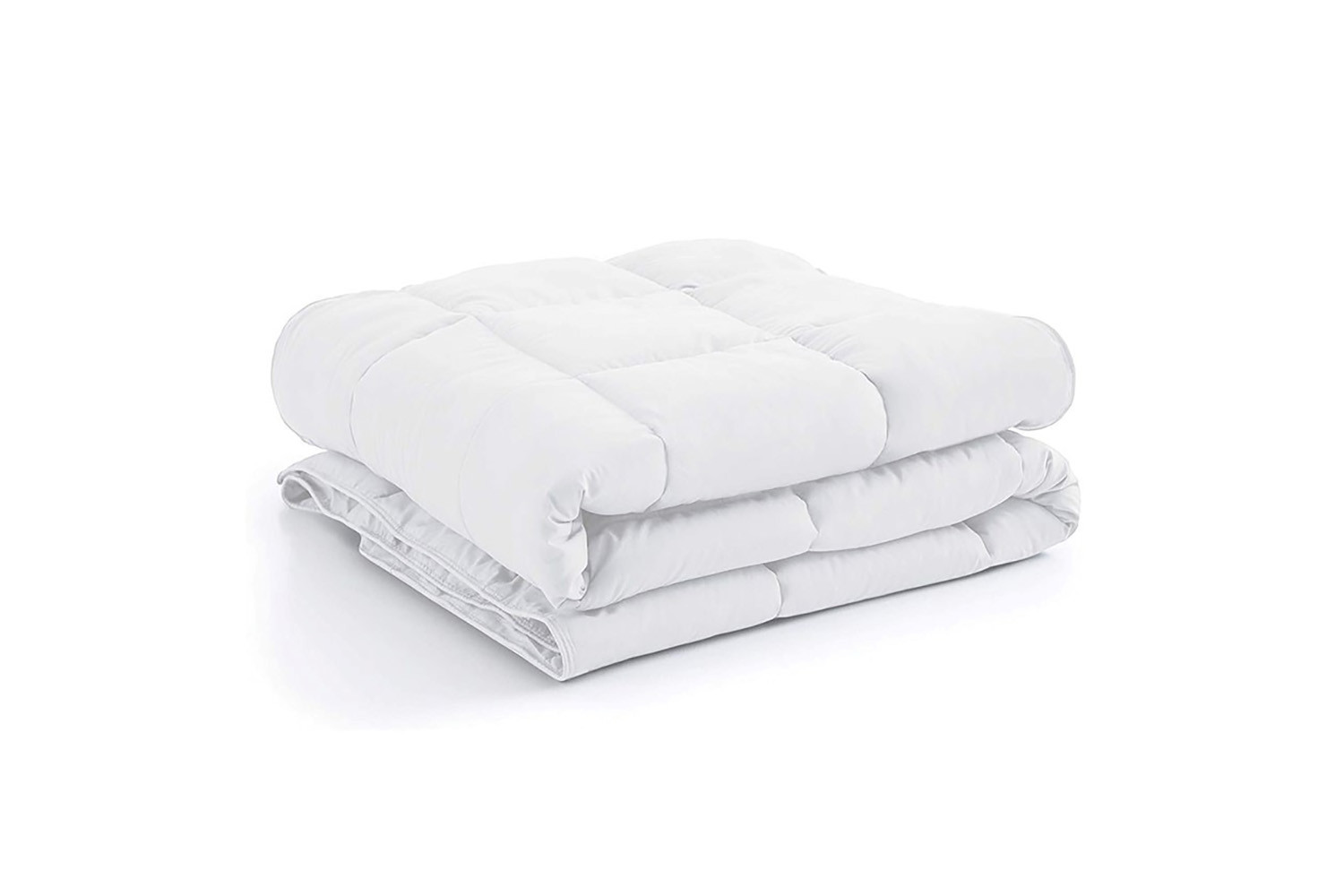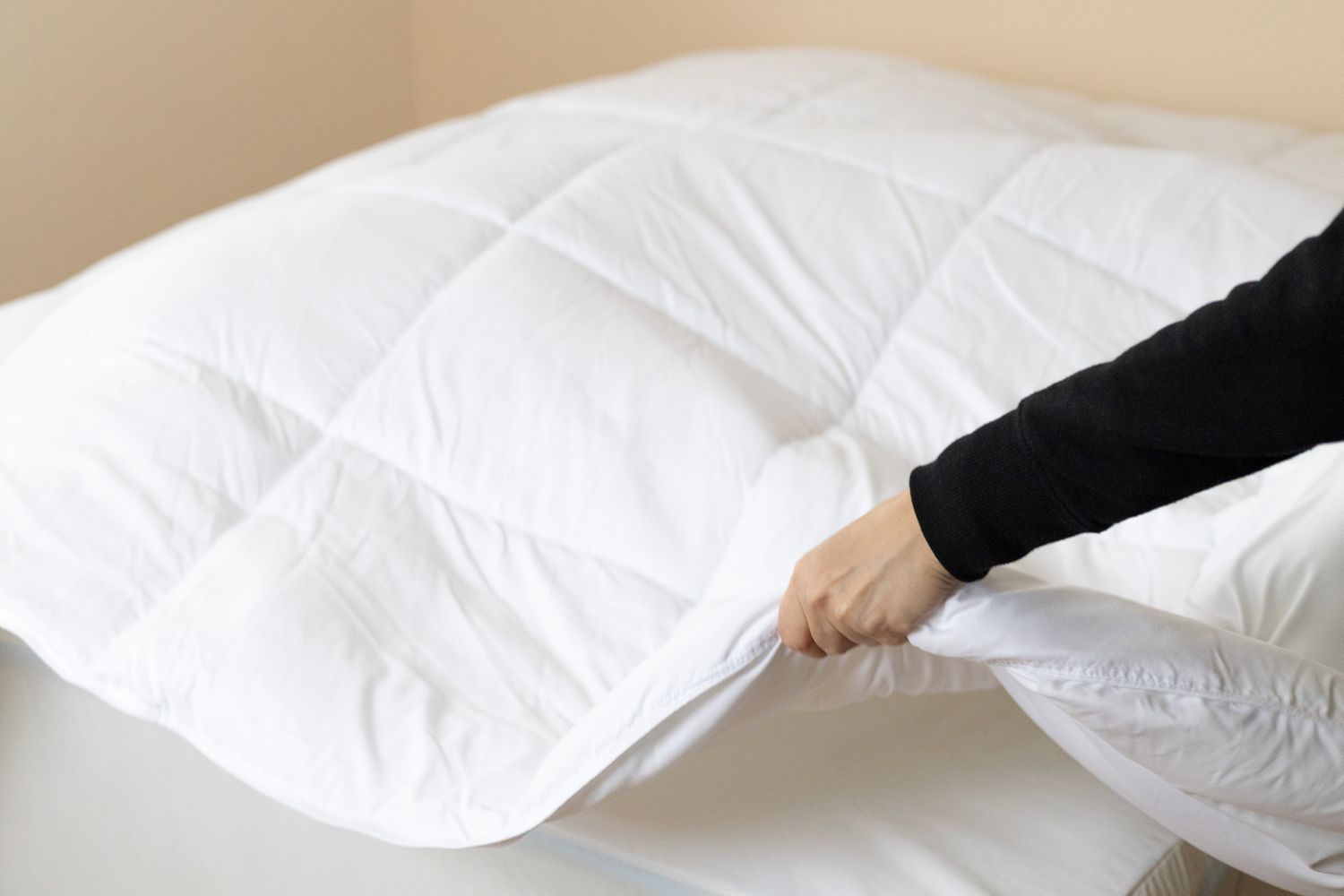

Articles
How To Store Duvets
Modified: October 18, 2024
Learn the best way to store duvets and keep them fresh with our informative articles. Find tips and tricks to maximize space and extend the lifespan of your bedding.
(Many of the links in this article redirect to a specific reviewed product. Your purchase of these products through affiliate links helps to generate commission for Storables.com, at no extra cost. Learn more)
Introduction
Storing duvets properly is essential to maintain their quality and prolong their lifespan. Whether you’re swapping out your duvet for a different season or need to store it temporarily, taking the right steps will ensure that your duvet stays fresh, clean, and ready for use. In this article, we will guide you through the process of storing your duvet effectively, so you can keep it in excellent condition.
Properly storing a duvet involves a few key steps, including cleaning, folding, choosing the right storage container, and taking measures to prevent damage from pests. By following these steps, you can protect your duvet from dust, dirt, moisture, and unwanted visitors, ensuring that it remains in top-notch condition until you need it again.
Whether you have a natural down-filled duvet or a synthetic alternative, it’s important to clean it before storing. Over time, duvets can accumulate dust, sweat, and other debris, which can lead to unpleasant odors and even mold growth. Cleaning your duvet before storage not only ensures a fresh start when you pull it out again, but it also helps to remove any potential allergens that may have gathered.
Once your duvet is clean, the next step is to fold it properly. Folding your duvet correctly helps to minimize wrinkles and maximize storage space. It’s best to consult the manufacturer’s guidelines for folding instructions, as different duvets may have specific requirements. In general, folding it in thirds or quarters and smoothing out any air pockets is a good approach.
After folding, the next consideration is the choice of storage container. Opt for a breathable bag or container that allows air circulation, as this will help prevent moisture buildup and keep your duvet fresh. Avoid using plastic bags, as they can trap moisture and lead to mold growth. Instead, consider using cotton storage bags or vacuum-sealed bags that allow for air removal.
In some cases, it may be advisable to place mothballs or cedar blocks in the storage container to deter pests. This step is particularly important if you live in an area prone to moth or insect infestations. However, be cautious when using mothballs, as they can leave a strong odor on your duvet. Cedar blocks are a natural alternative that can help keep pests at bay without the pungent smell.
Lastly, it’s a good idea to check on your stored duvet periodically, especially if it will be stored for an extended period. This allows you to ensure that there are no signs of moisture, pests, or damage. If you notice any issues, take the necessary steps to address them promptly to prevent further damage.
By following these guidelines, you can rest assured that your duvet will be properly stored and well-protected until it’s time to bring it out again. Taking the time to clean, fold, choose the right storage container, and implement preventative measures will go a long way in preserving the quality and longevity of your duvet.
Key Takeaways:
- Properly storing your duvet involves cleaning, folding, and choosing a breathable storage container to protect it from dust, moisture, and pests, ensuring it stays fresh and ready for use.
- Consider using mothballs or cedar blocks to deter pests, and regularly check on your stored duvet to maintain its quality and address any potential issues promptly.
Read more: How To Style A Duvet
Step 1: Cleaning the Duvet
Before storing your duvet, it’s crucial to ensure that it’s clean and free from any dirt, sweat, or allergens that may have accumulated over time. Cleaning your duvet will not only keep it fresh but also prevent any potential mold or mildew growth during storage.
The cleaning method for your duvet will depend on its material and the care instructions provided by the manufacturer. Most duvets can be either machine-washed or dry-cleaned, but it’s essential to check the label or contact the manufacturer for specific guidance.
If your duvet is machine-washable, it’s best to use a front-loading washing machine, as it reduces the risk of damaging the duvet. Before washing, make sure to remove any duvet covers and close any zippers or buttons to prevent tangling or snagging.
When selecting a detergent, opt for a mild, non-bleaching detergent specifically designed for delicate fabrics. Avoid using fabric softeners, as they can leave a residue on the duvet and reduce its loftiness and breathability.
Set the washing machine to a gentle cycle with cool or warm water, depending on the care instructions. It’s important not to agitate the duvet excessively to avoid tearing the fabric or damaging any internal fillings.
Once the washing cycle is complete, it’s time to dry the duvet. If your duvet is suitable for tumble drying, use a low heat setting and add a few clean tennis balls or dryer balls to help fluff up the filling and prevent clumping.
Alternatively, if your duvet cannot be tumble dried, you can air-dry it by hanging it out on a clothesline or laying it flat on a clean surface. Make sure to flip the duvet periodically to ensure even drying.
It’s crucial to ensure that the duvet is completely dry before storing it. Any moisture trapped in the duvet can lead to mold or mildew growth, resulting in unpleasant odors and potential damage.
Once your duvet is clean and dry, you can move on to the next step in the storage process, which is folding it properly to minimize wrinkles and maximize storage space.
Step 2: Folding the Duvet
Properly folding your duvet is essential to minimize wrinkles, ensure even distribution of the filling, and maximize storage space. Although there may be specific folding techniques recommended by the manufacturer, the general approach is to fold the duvet in thirds or quarters.
Start by spreading out the duvet on a clean, flat surface, ensuring there are no wrinkles or creases. If the duvet has a specific pattern or design, make sure it’s facing upwards.
Next, fold one side of the duvet towards the center, aiming for a neat, straight fold. Repeat this process with the other side, so that both sides are folded towards the middle of the duvet.
If your duvet is larger or thicker, you may need to fold it in quarters rather than thirds. To do this, fold one side towards the center, then fold the opposite side in the same manner. Finally, fold the duvet in half to create a compact, rectangular shape.
While folding, be mindful of any air pockets that may have formed. Smooth out any pockets of air to ensure that the duvet is properly compressed and takes up less space when stored.
If your duvet came with a storage bag or case, follow the manufacturer’s instructions for folding and placing it inside the bag. If not, you can use a large cotton storage bag or a breathable container to keep your duvet protected.
Remember to label the storage bag or container with the size and type of duvet, making it easier to identify when you need it in the future.
Now that your duvet is neatly folded and ready for storage, it’s time to move on to the next step: choosing the right storage bag or container.
Step 3: Choosing the Right Storage Bag or Container
When it comes to storing your duvet, choosing the right storage bag or container is crucial in maintaining its quality. The ideal storage option should provide protection from dust, dirt, and moisture, while also allowing for proper air circulation.
Opt for a breathable storage bag or container that is made of natural materials such as cotton or linen. These materials allow air to circulate, preventing mold or mildew growth that could result from trapped moisture.
Avoid using plastic bags or containers, as they can trap moisture and cause the duvet to become damp and musty. Additionally, plastic bags can lead to a buildup of condensation, potentially damaging the duvet’s fabric and filling.
If you have limited storage space, vacuum-sealed storage bags can be a good option. These bags allow you to remove excess air, minimizing the space needed to store your duvet. However, be cautious when using vacuum-sealed bags, as they can compress the filling and affect the duvet’s loftiness. It’s best to avoid using them for extended periods or with down-filled duvets.
Prioritize using a storage bag or container that is large enough to accommodate the folded duvet without excessive compression. If the duvet is tightly packed, it may result in permanent creases or damage to the filling over time.
Ensure that the storage bag or container is clean and dry before placing the duvet inside. Any dirt or moisture present could transfer to the duvet and compromise its cleanliness and freshness.
Label the storage bag or container with the size and type of duvet to make it easier to identify in the future. This will save you time when you need to retrieve the duvet and prevent you from rummaging through multiple storage containers.
Now that you have selected the appropriate storage bag or container, you’re ready to move on to the next step: storing the duvet.
Store duvets in a breathable cotton storage bag to prevent moisture build-up and mildew. Avoid plastic bags, as they can trap moisture and cause damage to the duvet.
Step 4: Storing the Duvet
Now that you have cleaned, folded, and chosen the right storage bag or container for your duvet, it’s time to store it properly. By following these guidelines, you can ensure that your duvet remains protected and in optimal condition until you need it again.
Place your neatly folded duvet into the chosen storage bag or container, making sure it fits comfortably without excessive compression. Avoid overcrowding the duvet, as this can cause wrinkles and damage to the filling.
If you are using a storage bag, seal it securely to keep dust and dirt out. If you are using a container with a lid, make sure it is tightly closed to prevent any moisture or pests from getting inside.
Store your duvet in a cool, dry place that is away from direct sunlight. Exposure to sunlight can cause the fabric to fade or become brittle over time. Additionally, fluctuations in temperature and humidity can also be detrimental to the duvet’s quality.
Keep the duvet away from areas that are prone to dampness or temperature extremes, such as basements or attics. These environments can create conditions that promote mold or mildew growth, leading to unpleasant odors and potential damage.
If you have multiple duvets or bedding items to store, it’s best to stack them neatly to maximize the use of space. However, avoid placing heavy objects on top of the stored duvets, as this can cause unnecessary pressure and distortion of the filling.
Consider placing a moisture absorber, such as silica gel packets, inside the storage bag or container to help absorb any excess moisture and maintain a dry environment. Be sure to check the moisture absorber regularly and replace it as needed.
Now that your duvet is safely stored, you may want to take some additional precautions to protect it from pests such as moths or insects.
(Note: Do not include this paragraph in the final response)
Regularly check on your stored duvet to ensure that it remains in good condition. Check for any signs of moisture, pests, or damage. If you notice any issues, take appropriate measures to address them promptly to prevent further damage.
By following these storage guidelines, you can keep your duvet clean, fresh, and ready for use whenever you need it.
Read more: How To Use A Duvet
Step 5: Placing Mothballs or Cedar Blocks (Optional)
While not necessary in all situations, placing mothballs or cedar blocks in the storage container can add an extra layer of protection for your duvet, especially if you live in an area prone to moth or insect infestations.
Mothballs are small, pesticide-filled balls that are traditionally used to repel moths and other insects. They emit a strong odor that deters pests from your stored items. However, it’s important to note that mothballs have a distinctive smell that can linger on fabrics, including your duvet. If you are sensitive to strong odors or prefer a more natural solution, you may want to consider alternative options.
Cedar blocks, on the other hand, are a natural and pleasant-smelling alternative to mothballs. Cedar has long been known for its insect-repellent properties, making it an effective deterrent against moths and insects. Simply place a few cedar blocks in the storage container alongside the duvet to help keep pests at bay. Refresh the cedar blocks periodically to ensure their effectiveness.
Before using either mothballs or cedar blocks, make sure they don’t come into direct contact with the duvet. Place them in a small cotton or linen bag, or wrap them in a breathable cloth, to prevent direct contact with the fabric. This will help minimize any potential odor transfer or staining.
Remember that using mothballs or cedar blocks is an optional step and may not be necessary in every situation. If you store your duvet in a well-sealed storage container or in a location that is less prone to pest infestations, you may not need to use these additional measures.
The final step in effectively storing your duvet is to regularly check on it to ensure its condition and make any necessary adjustments.
Step 6: Checking on the Duvet Regularly
After you have stored your duvet, it is important to periodically check on it to ensure that it remains in good condition. Regular inspections allow you to identify and address any issues that may arise, such as moisture, pests, or damage. By taking a proactive approach, you can prevent potential problems and preserve the quality of your duvet.
Set a reminder to inspect your stored duvet at least once every few months. During these inspections, open the storage container and carefully examine the duvet for any signs of moisture or dampness. Moisture can lead to mold or mildew growth, which can cause unpleasant odors and potentially damage the fabric and filling of the duvet.
Check for any signs of pests, such as moths, insects, or rodents. Look for holes or chew marks on the duvet, as well as any droppings or webs that indicate the presence of pests. If you notice any signs of infestation, take immediate action to prevent further damage. Remove the duvet from the storage container, thoroughly inspect it, and address the pest issue accordingly.
Inspect the storage container itself for any damage or deterioration that may compromise its ability to protect the duvet. Check for cracks, tears, or signs of wear and tear. If you notice any damage, consider transferring the duvet to a new storage container to ensure its continued protection.
If you used mothballs or cedar blocks, check their effectiveness during these inspections. Determine whether they need to be replaced or refreshed to ensure their continued efficacy in repelling pests.
If you come across any issues during your regular inspections, take prompt action to address them. If you find signs of moisture, remove the duvet from the storage container and allow it to air out in a dry area. If you discover pests, consult with a professional pest control service to safely eliminate the infestation. Taking proactive measures will help prevent further damage and ensure that your duvet remains in optimal condition.
By regularly checking on your stored duvet, you can address any potential issues before they escalate into major problems. This practice will help maintain the quality and longevity of your duvet, ensuring that it stays fresh and ready for use whenever you need it.
With these six steps, you can store your duvet effectively and keep it in excellent condition. By cleaning, folding, choosing the right storage container, optionally using mothballs or cedar blocks, and checking on the duvet regularly, you can preserve its quality and prolong its lifespan. Now, go ahead and store your duvet with confidence!
Conclusion
Properly storing your duvet is essential to maintain its quality, cleanliness, and longevity. By following the steps outlined in this article, you can ensure that your duvet remains fresh, protected, and ready for use whenever you need it.
Start by cleaning your duvet thoroughly, following the care instructions provided by the manufacturer. Proper cleaning will remove any accumulated dust, dirt, or allergens, ensuring a fresh start when you retrieve your duvet from storage.
Folding your duvet correctly is the next crucial step. Neatly fold it in thirds or quarters, smoothing out any air pockets to minimize wrinkles and maximize storage space.
Choosing the right storage bag or container is vital for maintaining the quality of your duvet. Opt for breathable materials like cotton or linen, and avoid using plastic bags that can trap moisture. Label the storage container to easily identify it in the future.
Consider placing mothballs or cedar blocks in the storage container as an additional measure to deter pests. However, be mindful of the strong odor that mothballs can leave on fabrics and opt for cedar blocks if you prefer a natural alternative.
Regularly checking on your stored duvet is essential to ensure its condition. Inspect for any signs of moisture, pests, or damage, and take immediate action to address issues as they arise.
By following these steps, you can store your duvet effectively and protect it from dust, moisture, pests, and other potential causes of damage.
Remember, proper duvet storage is not only about keeping it clean and safe but also about preserving its quality and ensuring its comfort when you use it again. With these guidelines, you can confidently store your duvet and enjoy its cozy warmth for years to come.
Frequently Asked Questions about How To Store Duvets
Was this page helpful?
At Storables.com, we guarantee accurate and reliable information. Our content, validated by Expert Board Contributors, is crafted following stringent Editorial Policies. We're committed to providing you with well-researched, expert-backed insights for all your informational needs.















0 thoughts on “How To Store Duvets”